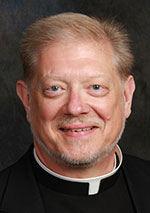That All May Be One / Fr. Rick Ginther
When can Catholics and other denominations pray together?
 Last month, I explored the many connections between Easter and Passover. Now I want to examine how we as Catholic Christians may pray ecumenically and interreligiously.
Last month, I explored the many connections between Easter and Passover. Now I want to examine how we as Catholic Christians may pray ecumenically and interreligiously.
St. John Paul II, Pope Benedict XVI, and Pope Francis all led gatherings of leaders of other religions at Assisi: St. John Paul in 1986, 1993 and 2002; Pope Benedict in 2011; and Pope Francis in 2016.
The choice of Assisi is rooted in St. Francis. He is a “universally admired figure for his commitment to peace, dialogue and simplicity” (John Allen, Crux, Sept. 15, 2016).
At each gathering, leaders of each religion prayed in their tradition, and their prayer was witnessed by the other participants. They were together, in one place. The prayers were rooted in shared longings. But those present were not “praying together.”
For 12 years through 2011, an Interfaith Thanksgiving Service was celebrated at SS. Peter and Paul Cathedral in Indianapolis.
Local leaders of Christian denominations and of other religions gathered to give thanks in word, song and reading from sacred texts. Each expressed their prayer in their tradition. The others witnessed.
If you or I were to be invited to an Islamic mosque, a Hindu temple, or a Sikh gurdwara, it would be ours to witness them at prayer. Our presence is appropriate. We witness their faith and their prayer practices. But their prayer is not rooted in our beliefs. It cannot be our prayer.
There is a somewhat frequent practice of Catholic and other Christian congregations going back a few decades to celebrate a seder meal at or around Passover. Often the thinking is that such a seder is a catechetical moment to make connections evident between the Passover meal and our Eucharist.
It is good for all Christians to honor Jewish customs, especially those with ties to our own. But it is not appropriate for Christians to carry them out themselves since we are not Jewish.
When Christians gather for prayer, we pray together. We have a common belief in the Trinity, in Jesus Christ as Savior and Lord. We share sacred Scripture. Thankfully, Christians pray together from time to time.
Some examples would be a wedding between a Catholic and another Christian or at a funeral service or Mass. Whether it is at a Catholic church or a Christian church, some roles may be shared.
For example, a non-Catholic may be a lector at a Catholic funeral Mass or wedding. A priest present for a Catholic and his or her family at a mixed religion wedding at a non-Catholic church may be asked to proclaim a reading and/or offer a prayer.
Another example would be at annual Lenten meals followed by a prayer service hosted among neighboring churches. The local church prayer forms are used. All are invited to participate.
There are some boundaries that need to be observed when an ecumenical prayer service or life ritual takes place.
The site of the celebration, as host, may have certain “dos and dont’s” when non-members are present. These should be honored by all present.
For Catholics, intercommunion with other Christians—whether in one of our churches or theirs—is not appropriate. Even if we are invited, we should refrain.
This is not to be rude, nor is it to demean the other’s communion celebration. This prohibition is rooted in Catholic tradition from the early Church until now. Reception of the Eucharist reflects credal unity and belief. This does not exist between us.
Many Christian denominations recognize this Catholic sensitivity. They offer a blessing to those not communing. In most of our Catholic churches, we offer the same.
What we can share in prayer, we do, through witnessing or communal enunciation. God hears. Can we doubt that God is glad?
(Father Rick Ginther is director of the archdiocesan Office of Ecumenism and Interreligious Affairs. He is also the pastor of Our Lady of Lourdes Parish, Indianapolis.) †
 Last month, I explored the many connections between Easter and Passover. Now I want to examine how we as Catholic Christians may pray ecumenically and interreligiously.
Last month, I explored the many connections between Easter and Passover. Now I want to examine how we as Catholic Christians may pray ecumenically and interreligiously.